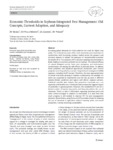Use este identificador para citar ou linkar para este item:
http://www.alice.cnptia.embrapa.br/alice/handle/doc/966904Registro completo de metadados
| Campo DC | Valor | Idioma |
|---|---|---|
| dc.contributor.author | BUENO, A. F. | pt_BR |
| dc.contributor.author | PAULA-MORAES, S. V. | pt_BR |
| dc.contributor.author | GAZZONI, D. L. | pt_BR |
| dc.contributor.author | POMARI, A. F. | pt_BR |
| dc.date.accessioned | 2013-09-23T11:11:11Z | pt_BR |
| dc.date.available | 2013-09-23T11:11:11Z | pt_BR |
| dc.date.created | 2013-09-23 | pt_BR |
| dc.date.issued | 2013 | pt_BR |
| dc.identifier.citation | Neotropical Entomology, v. 42, n. 5, p. 439-447, Oct. 2013. | pt_BR |
| dc.identifier.uri | http://www.alice.cnptia.embrapa.br/alice/handle/doc/966904 | pt_BR |
| dc.description | Increasing global demands for food underline the need for higher crop yields. The relatively low costs of the most commonly used insecticides in combination with increasing soybean market prices led growers and technical advisors to debate the adequacy of recommended economic thresholds (ETs). The adoption of ETs and pest sampling has diminished in Brazil, leading to excessive pesticide use on soybean. The reduced efficacy of natural biological control, faster pest resurgence, and environment contamination are among the side-effects of pesticide abuse. To address these problems and maximize agricultural production, pest control programs must be guided by a proper integrated pest management (IPM) approach, including the ET concept. Therefore, the most appropriate time to initiate insecticide spraying in soybean is indicated by the available ETs which are supported by experiments over the last 40 years in different edapho-climatic conditions and regions with distinct soybean cultivars. Published scientific data indicate that preventive insecticide use is an expensive and harmful use of chemicals that increases the negative impact of pesticides in agroecosystems. However, the established ETs are for a limited number of species (key pests), and they only address the use of chemicals. There is a lack of information regarding secondary pests and other control strategies in addition to insecticides. It is clear then that much progress is still needed to improve ETs for pest management decisions. Nevertheless, using the current ETs provides a basis for reducing the use of chemicals in agriculture without reducing yields and overall production, thereby improving sustainability. | pt_BR |
| dc.language.iso | eng | eng |
| dc.rights | openAccess | eng |
| dc.subject | Manejo integrado de pragas | pt_BR |
| dc.title | Economic thresholds in soybean-integrated pest management: old concepts, current adoption, and adequacy. | pt_BR |
| dc.type | Artigo de periódico | pt_BR |
| dc.date.updated | 2014-02-24T11:11:11Z | pt_BR |
| riaa.ainfo.id | 966904 | pt_BR |
| riaa.ainfo.lastupdate | 2014-02-24 | pt_BR |
| dc.identifier.doi | DOI 10.1007/s13744-013-0167-8 | pt_BR |
| dc.contributor.institution | ADENEY DE FREITAS BUENO, CNPSO; SILVANA VIEIRA DE PAULA MORAES, CPAC; DECIO LUIZ GAZZONI, CNPSO; ALINE FARHAT POMARI, USP. | pt_BR |
| Aparece nas coleções: | Artigo em periódico indexado (CNPSO)  | |
Arquivos associados a este item:
| Arquivo | Descrição | Tamanho | Formato | |
|---|---|---|---|---|
| art10.1007s1374401301678.pdf | 486.45 kB | Adobe PDF |  Visualizar/Abrir |









